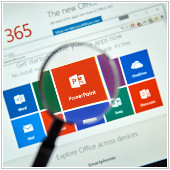 A clean work PC not only encourages employees to work harder, but it also prevents glitches and downtime linked to poorly maintained hardware. Clean PCs contribute to immaculate workspaces, which can positively affect employee morale and company reputation. Here’s how to clean your computers.
A clean work PC not only encourages employees to work harder, but it also prevents glitches and downtime linked to poorly maintained hardware. Clean PCs contribute to immaculate workspaces, which can positively affect employee morale and company reputation. Here’s how to clean your computers.
Cleaning desktop monitors
Employees spend many hours looking at their computer monitors, and a clean monitor makes it easier for them to do their tasks. The best way to clean your monitor is to turn it off first and gently wipe the screen with a microfiber cloth.
If there are still spots, try dipping the cloth in a tiny bit of water — make sure you don’t spray water onto the screen. Don’t press too hard on the screen, as this could damage your monitor’s pixels. Also, it is not a good idea to use paper products like paper towels or tissues, as they will not only leave a residue, but may also slightly scratch the monitor.
Cleaning mobile screens
Mobile and other touch screen devices will usually get your fingerprints all over them. The best way to clean these screens is also with a microfiber cloth. For tougher spots, dip the cloth in a small amount of water and then gently wipe the screen. Don’t splash water onto the device itself, as water could get inside, ruin internal components, and void the warranty.
Some people suggest rubbing alcohol to remove fingerprints and disinfect the device. While this will be okay for some screens, many manufacturers recommend against it because the alcohol can eat away at the protective film on some devices.
If you notice that there is a lot of dust or gunk on the edges of your screen, or even in cracks, you may need to take the device to a mobile shop for more thorough cleaning. Do not open the device yourself, as this could void the warranty.
Cleaning your keyboard
Because we use keyboards almost every day, they may get a bit grungy, with debris and dirt accumulating between the keys. Before you start cleaning, be sure to unplug the keyboard, or turn it off if it is wireless. To clean the upper parts of the keys — where your fingers strike the keys — try dipping cotton swabs into rubbing alcohol and then cleaning the keys with a gentle rub.
To clean between keys, you will need compressed air, which can be purchased at most office supply and computer stores. Spraying in between keys should be enough to get rid of most of the dust and grit.
Cleaning your mouse
Like the keyboard, the mouse can get quite dirty with grime from your fingers and dust. To clean a mouse, unplug it first then use cotton swabs dipped in rubbing alcohol to gently clean it. There’s no need to open your mouse, as most models are designed to not be opened by users.
Cleaning your laptop’s body
To clean your laptop’s body, turn it off, unplug it, and clean it with cotton swabs dipped in rubbing alcohol, or Mr. Clean Magic Eraser or a similar cleaning agent. Be careful not to scratch the sensitive components of the body.
Cleaning your computer tower
You may also clean the desktop computer’s tower by taking a slightly damp microfiber cloth and wiping down the front and sides of the tower. However, we strongly recommend avoiding the back and certain areas of the front, as there are ports and components that could be easily damaged.
As always, be sure to disconnect the power source and all wires before cleaning, as any water damage could ruin your computer.
Cleaning the inside of your computer
Dust will eventually get inside your computer and clog up cooling fans, causing them to stop working properly. This can potentially lead to other components overheating. The internal components of your computer are extremely fragile and need to be handled with great care. Do not take the case off of your computer, as this usually voids your warranty.
For all of your computer needs, our technicians are here to help.

 A tidy workstation can help employees become high achievers. Cleanliness also contributes to employee health, safety, and better office hardware maintenance. Is it time for you to prioritize cleanliness in your company? Keep your computers dirt- and dust-free with these tips.
A tidy workstation can help employees become high achievers. Cleanliness also contributes to employee health, safety, and better office hardware maintenance. Is it time for you to prioritize cleanliness in your company? Keep your computers dirt- and dust-free with these tips. Leaving work PCs, tablets, and similar machines to accumulate dirt can lead to distractions, glitches, and worse, hardware failure. To avoid these situations, you must properly care for your employees’ work computers. Here are a few tips to keep them clean.
Leaving work PCs, tablets, and similar machines to accumulate dirt can lead to distractions, glitches, and worse, hardware failure. To avoid these situations, you must properly care for your employees’ work computers. Here are a few tips to keep them clean. If you want to use Microsoft Office in your company, you can either purchase Microsoft Office 2019 or sign up for the cloud-based version, Office 365. Both versions contain many of the same standard features, but how are they different from each other and which one is more suitable to your needs?
If you want to use Microsoft Office in your company, you can either purchase Microsoft Office 2019 or sign up for the cloud-based version, Office 365. Both versions contain many of the same standard features, but how are they different from each other and which one is more suitable to your needs? Microsoft Office is one of the most installed software suites in the world. If you are looking to integrate it into your company, you can either purchase Microsoft Office 2019 or sign up for cloud-based Office 365. Both promise the same features that the Office suite is known for, but they are different enough to be better suited to some users than others.
Microsoft Office is one of the most installed software suites in the world. If you are looking to integrate it into your company, you can either purchase Microsoft Office 2019 or sign up for cloud-based Office 365. Both promise the same features that the Office suite is known for, but they are different enough to be better suited to some users than others. Microsoft Office is one of the most popular productivity suites for businesses. Over the years, Microsoft has released several versions of the product, all of which were designed to target different users or update outdated features. Two of the suite’s latest iterations, Office 365 and Microsoft Office 2019, contain many of the same standard applications, but users should pay close attention to their differences when deciding which one to purchase.
Microsoft Office is one of the most popular productivity suites for businesses. Over the years, Microsoft has released several versions of the product, all of which were designed to target different users or update outdated features. Two of the suite’s latest iterations, Office 365 and Microsoft Office 2019, contain many of the same standard applications, but users should pay close attention to their differences when deciding which one to purchase. Running a business can be time-consuming, especially if you’re managing staff, looking for growth opportunities, and looking after clients. This leaves you little time to search for an IT system that can benefit your business. Because of this, you may be forced to make an impulsive technology purchase that does more harm than good. To avoid this, here are five IT investment mistakes you should be aware of.
Running a business can be time-consuming, especially if you’re managing staff, looking for growth opportunities, and looking after clients. This leaves you little time to search for an IT system that can benefit your business. Because of this, you may be forced to make an impulsive technology purchase that does more harm than good. To avoid this, here are five IT investment mistakes you should be aware of. Small- and medium-sized business owners have a lot to do. Aside from managing their staff, exploring new opportunities for growth, and keeping clients happy, they have to oversee investments in new technology. Being busy, they can easily commit mistakes when choosing the right IT solution. Here’s a list of common IT investment missteps that owners like you should avoid.
Small- and medium-sized business owners have a lot to do. Aside from managing their staff, exploring new opportunities for growth, and keeping clients happy, they have to oversee investments in new technology. Being busy, they can easily commit mistakes when choosing the right IT solution. Here’s a list of common IT investment missteps that owners like you should avoid. Business owners aren’t perfect. They’re human and sometimes make costly mistakes. If you want to succeed as a business owner, learn from others and try to avoid making bad moves. Be wary of the things you purchase and think twice before parting with your hard-earned money. Here are five mistakes to avoid when investing in new technology.
Business owners aren’t perfect. They’re human and sometimes make costly mistakes. If you want to succeed as a business owner, learn from others and try to avoid making bad moves. Be wary of the things you purchase and think twice before parting with your hard-earned money. Here are five mistakes to avoid when investing in new technology. Social media accounts for businesses are invaluable tools enterprises use to reach out to their client bases to fully understand their needs and wants. Make sure your social media manager understands the proper way to interact with people online, especially those with bad things to say about the company.
Social media accounts for businesses are invaluable tools enterprises use to reach out to their client bases to fully understand their needs and wants. Make sure your social media manager understands the proper way to interact with people online, especially those with bad things to say about the company. Social media management for businesses can be boiled down to two simple sentences: The internet is full of trolls. Don’t feed the trolls. Read on to find out more about social media gaffes that you will want to avoid, especially when dealing with negative comments on your business posts.
Social media management for businesses can be boiled down to two simple sentences: The internet is full of trolls. Don’t feed the trolls. Read on to find out more about social media gaffes that you will want to avoid, especially when dealing with negative comments on your business posts. Current trends show that personalized interactions help establish a business’s persona or identity with prospective customers. This makes the business more relatable and therefore more attractive to more consumers. To use this opportunity properly, social media managers should know how to keep their wits together, especially in the face of negativity online. Read on to learn more.
Current trends show that personalized interactions help establish a business’s persona or identity with prospective customers. This makes the business more relatable and therefore more attractive to more consumers. To use this opportunity properly, social media managers should know how to keep their wits together, especially in the face of negativity online. Read on to learn more.